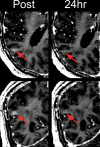Blood-brain barrier opening with focused ultrasound in Parkinson's disease dementia
- PMID: 33536430
- PMCID: PMC7859400
- DOI: 10.1038/s41467-021-21022-9
Blood-brain barrier opening with focused ultrasound in Parkinson's disease dementia
Abstract
MR-guided focused ultrasound (MRgFUS), in combination with intravenous microbubble administration, has been applied for focal temporary BBB opening in patients with neurodegenerative disorders and brain tumors. MRgFUS could become a therapeutic tool for drug delivery of putative neurorestorative therapies. Treatment for Parkinson's disease with dementia (PDD) is an important unmet need. We initiated a prospective, single-arm, non-randomized, proof-of-concept, safety and feasibility phase I clinical trial (NCT03608553), which is still in progress. The primary outcomes of the study were to demonstrate the safety, feasibility and reversibility of BBB disruption in PDD, targeting the right parieto-occipito-temporal cortex where cortical pathology is foremost in this clinical state. Changes in β-amyloid burden, brain metabolism after treatments and neuropsychological assessments, were analyzed as exploratory measurements. Five patients were recruited from October 2018 until May 2019, and received two treatment sessions separated by 2-3 weeks. The results are set out in a descriptive manner. Overall, this procedure was feasible and reversible with no serious clinical or radiological side effects. We report BBB opening in the parieto-occipito-temporal junction in 8/10 treatments in 5 patients as demonstrated by gadolinium enhancement. In all cases the procedures were uneventful and no side effects were encountered associated with BBB opening. From pre- to post-treatment, mild cognitive improvement was observed, and no major changes were detected in amyloid or fluorodeoxyglucose PET. MRgFUS-BBB opening in PDD is thus safe, reversible, and can be performed repeatedly. This study provides encouragement for the concept of BBB opening for drug delivery to treat dementia in PD and other neurodegenerative disorders.
Conflict of interest statement
JAO has attended board meetings of Insightec and received an honorarium. RMF received honoraria for lecturing and payment to attend scientific meetings from Insightec. The other authors declare no competing interests.
Figures




Similar articles
-
Striatal Blood-Brain Barrier Opening in Parkinson's Disease Dementia: A Pilot Exploratory Study.Mov Disord. 2022 Oct;37(10):2057-2065. doi: 10.1002/mds.29134. Epub 2022 Jun 28. Mov Disord. 2022. PMID: 35765711 Clinical Trial.
-
Focused ultrasound-mediated blood-brain barrier opening in Alzheimer's disease: long-term safety, imaging, and cognitive outcomes.J Neurosurg. 2022 Nov 4;139(1):275-283. doi: 10.3171/2022.9.JNS221565. Print 2023 Jul 1. J Neurosurg. 2022. PMID: 36334289
-
Blood-Brain Barrier Opening with MRI-guided Focused Ultrasound Elicits Meningeal Venous Permeability in Humans with Early Alzheimer Disease.Radiology. 2021 Mar;298(3):654-662. doi: 10.1148/radiol.2021200643. Epub 2021 Jan 5. Radiology. 2021. PMID: 33399511 Free PMC article. Clinical Trial.
-
A review of potential applications of MR-guided focused ultrasound for targeting brain tumor therapy.Neurosurg Focus. 2018 Feb;44(2):E10. doi: 10.3171/2017.11.FOCUS17620. Neurosurg Focus. 2018. PMID: 29385922 Review.
-
Innovative Applications of MR-Guided Focused Ultrasound for Neurological Disorders.World Neurosurg. 2021 Jan;145:581-589. doi: 10.1016/j.wneu.2020.08.052. World Neurosurg. 2021. PMID: 33348524 Review.
Cited by
-
Anti-Parkinsonian Therapy: Strategies for Crossing the Blood-Brain Barrier and Nano-Biological Effects of Nanomaterials.Nanomicro Lett. 2022 Apr 15;14(1):105. doi: 10.1007/s40820-022-00847-z. Nanomicro Lett. 2022. PMID: 35426525 Free PMC article. Review.
-
Exploiting Focused Ultrasound to Aid Intranasal Drug Delivery for Brain Therapy.Front Pharmacol. 2022 Apr 14;13:786475. doi: 10.3389/fphar.2022.786475. eCollection 2022. Front Pharmacol. 2022. PMID: 35496270 Free PMC article.
-
Characterization of focused ultrasound blood-brain barrier disruption effect on inflammation as a function of treatment parameters.Biomed Pharmacother. 2025 Jan;182:117762. doi: 10.1016/j.biopha.2024.117762. Epub 2024 Dec 23. Biomed Pharmacother. 2025. PMID: 39719739 Free PMC article.
-
The Role of Acoustic Parameters in Droplet Vaporization of Perfluoropentane Nanodroplets for In Vivo Applications.ACS Appl Mater Interfaces. 2025 Jul 2;17(26):37562-37576. doi: 10.1021/acsami.5c05638. Epub 2025 Jun 16. ACS Appl Mater Interfaces. 2025. PMID: 40522706 Free PMC article.
-
The intersection of circadian rhythms and the blood-brain barrier with drug efficacy and delivery in neurological disorders.Adv Drug Deliv Rev. 2025 Sep;224:115645. doi: 10.1016/j.addr.2025.115645. Epub 2025 Jul 2. Adv Drug Deliv Rev. 2025. PMID: 40614866 Review.
References
Publication types
MeSH terms
Substances
Associated data
LinkOut - more resources
Full Text Sources
Other Literature Sources
Medical

